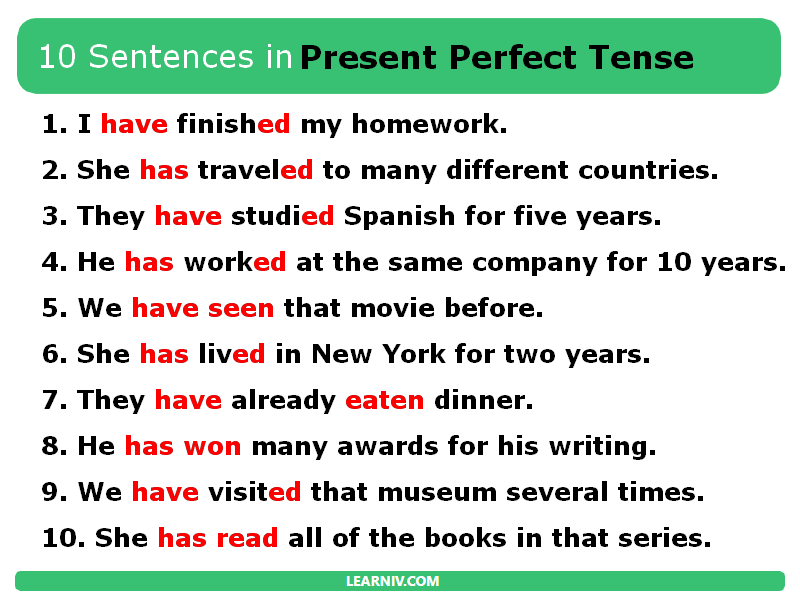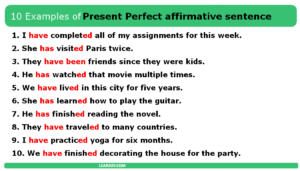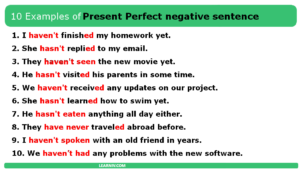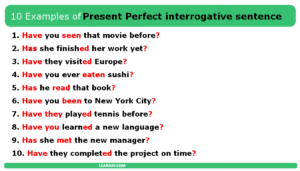
The present perfect tense is a verb tense used to describe actions or events that have occurred at an unspecified time in the past or that began in the past and continue into the present. It is formed by using the auxiliary verb “have” (or “has” for third-person singular subjects) followed by the past participle of the main verb.
For example, “I have eaten breakfast” means that the speaker ate breakfast at an unspecified time in the past, but it does not specify exactly when the action occurred.
10 Examples of sentences of Present Perfect Tense
- I have finished my homework.
- She has traveled to many different countries.
- They have studied Spanish for five years.
- He has worked at the same company for 10 years.
- We have seen that movie before.
- She has lived in New York for two years.
- They have already eaten dinner.
- He has won many awards for his writing.
- We have visited that museum several times.
- She has read all of the books in that series.
Use of the Present Perfect Tense
The present perfect tense is often used to talk about past experiences or actions that have relevance to the present. It can also be used to describe a recent past action that has a connection to the present.
Here are some common usages of the present perfect tense:
- To talk about experiences or accomplishments: “I have traveled to many different countries.”
- To talk about past actions with a connection to the present: “I have studied Spanish for five years, so I can speak it fluently now.”
- To talk about past actions that have a result or impact on the present: “He has worked at the same company for 10 years, so he knows everyone well.”
- To talk about past actions that are unfinished or ongoing: “She has lived in New York for two years and is still living there now.”
- To talk about past actions that occurred at an unspecified time in the past: “We have seen that movie before, but I don’t remember when.”
Overall, the present perfect tense is a useful way to describe past actions or events that are still relevant to the present, or that have an ongoing impact on the present.
Grammatical rules
Here are the rules for forming sentences in the present perfect
- Formation: The present perfect tense is formed by using the helping verb “have” (or “has” for third-person singular subjects) followed by the past participle of the main verb. For example: “I have eaten breakfast” or “She has finished her work.”
- Negation: To make a negative sentence in the present perfect tense, “not” is added after “have” or “has.” For example: “I have not eaten breakfast yet” or “She has not finished her work.”
- Interrogative: To form a question in the present perfect tense, the auxiliary verb “have” (or “has”) is placed before the subject. For example: “Have you eaten breakfast yet?” or “Has she finished her work?”
Overall, the present perfect tense is a flexible and useful tense for describing past actions or events that have relevance to the present. By following these grammatical rules, you can use this tense effectively in your writing and speech.
And other rules for using present perfect
- Irregular verbs: Some verbs have irregular past participles, such as “go” (gone), “eat” (eaten), and “see” (seen). These verbs follow their own rules for forming the past participle.
- Time expressions: The present perfect tense is often used with time expressions that indicate an unspecified time in the past, such as “ever,” “never,” “already,” “yet,” and “just.” For example: “Have you ever been to Paris?” or “I haven’t finished my work yet.”
- Use of “since” and “for”: The present perfect tense is often used with the words “since” and “for” to describe actions or events that started in the past and continue into the present. “Since” is used with a specific point in time, while “for” is used with a duration of time. For example: “I have been studying Spanish since high school” or “She has been living in New York for two years.”
More examples of Present Perfect sentences
Other examples:
- 5 examples of sentences of Present Perfect tense
- 10 examples of sentences of Present Perfect tense
- 20 examples of sentences of Present Perfect tense
- 50 examples of sentences of Present Perfect tense
- Present Perfect irregular and regular verbs list


